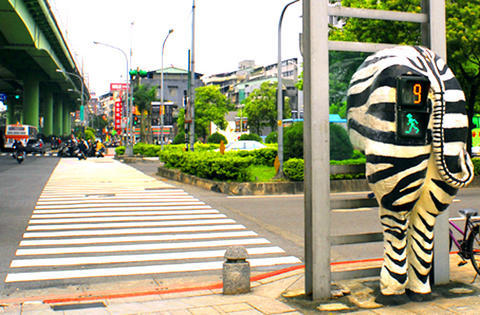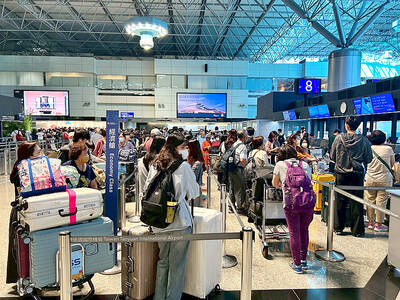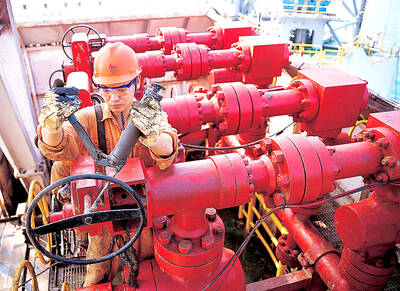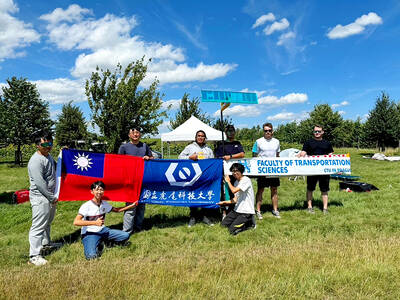A giant red birdcage encapsulating a tree on the traffic island at the intersection of Dunhua South Road and Anhe Road and several colorful chairs lined up a few steps away blend into the environment to shape one of the most recognizable public artworks in Taipei City.
The Garden Outside of a Birdcage was one of the nine pieces of art commissioned by the Taipei City Government in 1999 in a project called the Dunhua Public Art Vestibule, which aimed at adding artistic features to one of the city's major streets and giving Taipei a facelift.
"The birdcage symbolized the city, whereas the tree represented the nature and life. The piece is a conversation between the city and nature, and an urban garden to help people relax their mind and body," artist May Hsu (

PHOTO PROVIDED BY TAIPEI CITY'S DEPARTMENT OF CULTURAL AFFAIRS
Installed at a time when public art was still a new concept for many residents, her piece and other works in the project made art more accessible to people and encouraged their interaction with art, Hsu said.
The red birdcage, for example, became street furniture for many people, who would sit in it or on the balustrade while taking a short break. For some, it can even be a prayer tree, as Hsu once found a note tied on top of the birdcage by a student praying for good grades.
"It is interesting to see how people interact with the birdcage. [They do so] in many creative ways," she said.
Thanks to continuous efforts by the city government to increase the amount of art in the city, residents can also enjoy public art near the Dihua Sewage Treatment Plant, Nankang Software Park, Civil Boulevard, the Xinyi district and at more than 15 mass-rapid transportation (MRT) stations.
From the zebra's behind at the intersection of Dunhua North Road and Civic Boulevard, Robert Indiana's Love sculpture in front of Taipei 101, to the Suite of Hands at the NTU Hospital MRT station, a total of 305 public artworks including sculpture, paintings and mosaics are now scattered throughout public spaces in the capital.
Public art in Taiwan began to flourish after 1998 when the Council of Cultural Affairs launched the Public Art Establishment Measures (公共藝術設置辦法), which stipulated that owners of public buildings should set up artwork with an expenditure of no less than 1 percent of the construction budget.
The Taipei City Government became the first local government to establish a Public Art Fund in 2005 to manage its municipal public art budget and assist owners of public buildings with displaying art works, said Wang Yi-chun (王逸群), a division chief at the city's Department of Cultural Affairs who oversees the public art projects.
Wang said more art is on the way, as an amendment to the measures that becomes effective in May will encourage architects to design public buildings as works of art while simplifying the review process of public art installation.
Taipei's latest piece of art, Wang said, can be seen during the Taipei Lantern Festival, which begins on Saturday along Renai Road and at Sun Yat-sen Memorial Hall.
Rather than simply having a mascot this year, the department invited architect Liu Kuo-chan (劉國滄) to design a piece of art, which includes a 9m-diameter red lantern made up of hundreds of plastic rats and the memorial hall itself, which will be wrapped in red and gold cloth.
"The main lantern tells the story of a rat getting married and the hall is its new house. Hopefully the integration of the lantern and the site will make a deep impression on people," Liu told the Taipei Times.
Another new public art project is a giant embroidery piece featuring Neihu's landscape created by local community members that will be displayed inside the Neihu MRT Station once the Neihu line becomes operational, Wang said.
Ziqiang Tunnel (
While lauding the city's efforts to promote public art, Hsu urged the city government to take better care of its artworks.
Wang said each of the city's public art pieces is maintained by a different department.
In addition to regular maintenance, Wang said the cultural affairs department would eliminate outdated artwork and place more emphasis on the integration of public art and the environment.

The Chinese military has built landing bridge ships designed to expand its amphibious options for a potential assault on Taiwan, but their combat effectiveness is limited due to their high vulnerability, a defense expert said in an analysis published on Monday. Shen Ming-shih (沈明室), a research fellow at the Institute for National Defense and Security Research, said that the deployment of such vessels as part of the Chinese People’s Liberation Army (PLA) Navy’s East Sea Fleet signals a strong focus on Taiwan. However, the ships are highly vulnerable to precision strikes, which means they could be destroyed before they achieve their intended

About 4.2 million tourist arrivals were recorded in the first half of this year, a 10 percent increase from the same period last year, the Tourism Administration said yesterday. The growth continues to be consistent, with the fourth quarter of this year expected to be the peak in Taiwan, the agency said, adding that it plans to promote Taiwan overseas via partnerships and major events. From January to June, 9.14 million international departures were recorded from Taiwan, an 11 percent increase from the same period last year, with 3.3 million headed for Japan, 1.52 million for China and 832,962 to South Korea,

SOVEREIGNTY: The rigs show that Beijing ‘rejects Taiwan’s jurisdiction’ by building in areas where Taipei demands permission to build or alter installations Chinese oil rigs have been sighted just 26 nautical miles (42km), from Taiwan’s exclusive economic zone (EEZ) near Pratas Island (Dongsha Island, 東沙島), posing a threat to Taiwan’s sovereignty if left unchallenged, a brief published by the Jamestown Foundation on Tuesday said. Pratas Island, 444km from Kaohsiung, is northeast of the South China Sea and houses a Taiwanese garrison. The brief, titled “Rigging the Game: PRC Oil Structures Encroach on Taiwan’s Pratas Island” — referring to the People’s Republic of China — analyzed photographs and said that Beijing’s tools to pressure Taiwan now include oil rigs. “Oil rigs now constitute part of Beijing’s

The Taiwan Experience Education Program (TEEP) has funded short-term internships in Taiwan for more than 4,500 young people from more than 40 countries since 2015, with the goal of attracting and retaining international talent, the Ministry of Education said yesterday. Fifty-five colleges launched 514 projects this year, including in fields such as semiconductors, artificial intelligence, medicine and biotechnology, green energy, and sustainability, it said. The program provides research and practical internships in Taiwan for two to six months, and offers cultural exchange and networking opportunities, the ministry said. For example, National Formosa University’s Embedded System and Autopilot Laboratory developed two solar-powered drones in